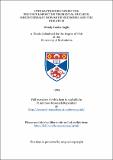Files in this item
Interactions between the pedunculopontine tegmental nucleus, mesencephalic dopamine neurones and the striatum
Item metadata
| dc.contributor.advisor | Winn, Philip | |
| dc.contributor.author | Inglis, Wendy Louise | |
| dc.coverage.spatial | 330 p. | en_US |
| dc.date.accessioned | 2018-06-29T09:38:38Z | |
| dc.date.available | 2018-06-29T09:38:38Z | |
| dc.date.issued | 1994 | |
| dc.identifier.uri | https://hdl.handle.net/10023/14738 | |
| dc.description.abstract | The role of the pedunculopontine tegmental nucleus (PPTg) in the control of behaviour is investigated in the experiments in this thesis through (1) the interactions between its ascending cholinergic neurones and dopamine neurones in the substantia nigra and ventral tegmental area; and (2) the involvement of its non- cholinergic neurones in modifying outflow from the striatum. (1) Stimulation of rat SN by carbachol produces an increase in behaviours for which the animal has a low current baseline rate and a positive predisposition (Winn et al, 1983). This was investigated further by examining first, whether consumption of a palatable food could also be stimulated by intranigral injections of nicotine or acetylcholinesterase inhibitors. Increased feeding was obtained dose- dependently from satiated rats following injection of carbachol, nicotine or neostigmine, but not eserine, into the substantia nigra. Second, it was demonstrated that spontaneous consumption by satiated rats could not be blocked by muscarinic or nicotinic antagonists, although eating stimulated by intranigral neostigmine were attenuated by these antagonists. These data suggest that the cholinergic innervation of substantia nigra is phasic in nature. Third, it was ascertained whether the excitation realised by neostigmine injections into the substantia nigra or ventral tegmental area could support the acquisition of responding for conditioned reinforcement. Injections of neostigmine into the substantia nigra, but not ventral tegmental area, assisted acquisition of the lever-press response and this resuh is discussed with respect to the significance of habit and expectation on responding. (2) The PPTg has been viewed as an important striatal output station for several years, primarily due to its proposed function as part of the mesencephalic locomotor region but more recently for its role in incentive behaviours. The validity of these perspectives was tested first by investigating the effects of ibotenate PPTg lesions on the well-known pattern of events which occur following systemic injections of d-amphetamine and apomorphine. The effects of lesions made in the deep mesencephalic nucleus were also investigated as this structure has also been linked with locomotor functions. Neither spontaneous nor drug-induced locomotion was affected by either lesion placement, but PPTg-lesioned rats exhibited abnormal stereotypies. At 3.0 and 5.0 mg-kg-1 d-amphetamine these included excessive biting behaviour, predominantly directed at their own forepaws, and they were the only group to score 6 (continuous biting) on the Creese-Iversen scale following apomorphine injections. The role of the PPTg in the mediation of reward-related behavior was investigated in the conditioned reinforcement paradigm. Ibotenate-lesioned rats responded as frequently as controls on the CR lever, but their pressing was equal on CR and NCR levers. These data are discussed with respect to a role for the non-cholinergic neurones in the PPTg in the mediation of stimulus-reward associations and a possible role for the cholinergic neurones in the integration of such associations back into basal ganglia and cortical circuitry. It is also suggested that the PPTg may have a role in the selection of appropriate and inhibition of inappropriate behaviours. | en_US |
| dc.language.iso | en | en_US |
| dc.publisher | University of St Andrews | |
| dc.subject.lcc | QP376.8I6 | |
| dc.subject.lcsh | QP376.8I6 | |
| dc.title | Interactions between the pedunculopontine tegmental nucleus, mesencephalic dopamine neurones and the striatum | en_US |
| dc.type | Thesis | en_US |
| dc.contributor.sponsor | Wellcome Trust | en_US |
| dc.type.qualificationlevel | Doctoral | en_US |
| dc.type.qualificationname | PhD Doctor of Philosophy | en_US |
| dc.publisher.institution | The University of St Andrews | en_US |
This item appears in the following Collection(s)
Items in the St Andrews Research Repository are protected by copyright, with all rights reserved, unless otherwise indicated.

